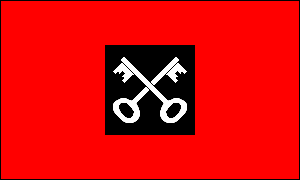Flag of the 2nd Division (British Army)
 by Tom Gregg
by Tom Gregg
Last modified: 2001-11-03 by rob raeside
Keywords: united kingdom | army | regimental flags | keys: crossed | royal artillery |
Links: FOTW homepage |
search |
disclaimer and copyright |
write us |
mirrors
See also:
'Regimental flags' (not to be confused with 'regimental colours') are roughly the equivalent of what the Canadians call a 'camp flag'. I have seen several examples, but I have never seen a comprehensive reference to these flags. As far as I can make out, they are post World War II innovations, have virtually no official status, and exist at regimental discretion. These flags are flown from poles, as opposed to colours/standards/guidons which are carried on parade.
Royal Regiment of Fusiliers: St. George Cross with a central badge consisting of the regimental crest in proper colours (St. George and his dragon within a crowned Garter). The crest is often different from the cap badge - in this case the badge would be St. George on a flaming grenade.
Royal Irish Regiment: a green flag with a thin horizontal blue stripe edged red (i.e. the red stripes are half the width of the blue), with the regimental badge (silver crowned Irish harp surrounded by wreath of clovers).
Royal Highland Fusiliers: The regiment was formed in 1959 by amalgamation of the the Royal Scots Fusiliers and the Highland Light Infantry. The latter had two flags: (1) St. Andrew's cross, and (2) regimental monogram (HLI) and crown on a buff field. The former had three flags, and these were adopted by the new regiment due to their 'antiquity'. The 'Colonel's Flag' is white with a crowned thistle surrounded by the motto Nemo Me Impune Lacessit (motto of Scotland and the regiment). It is flown when the colonel is on parade. The 'Lieutenant Colonel's Flag' is a St. Andrew's Cross with a four-pointed white star superimposed. The points are wavy, extending into the blue quadrants almost to the edge of the flag. In the centre is the same crest as the Colonel's Flag. This is flown daily in barracks or camp. The 'Major's Flag' is identical to the Lieutenant Colonel's with the addition of a red pile wavy extending from the top left corner almost to the central badge. This is flown when command of the battalion devolves to the second in command, or when a major has an independent operational command of part of the regiment. These three flags are copies of the three senior colours in use prior to 1747 (every company had a colour). In that year regimental colours were limited to two per battalion, and their design became much more closely regulated.
T.F. Mills, 3 June 1998
Flag of the 2nd Division (British Army)
 by Tom Gregg
by Tom Gregg
In past discussions it has been stated that there are no distinguishing flags for the divisions and brigades of the British Army. However, on the British Army web site, and I came upon the flag of the 2nd Division. It was shown in a